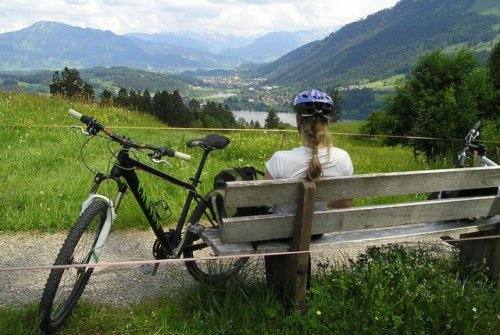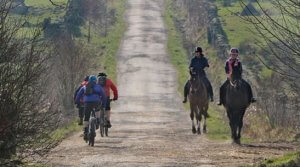Best Biking Routes In Spain

Tourism and travel are one of life’s great pleasures; exploring new places on a bike and enjoying beautiful landscapes are a rewarding experience. Moreover, when you’re also helping the environment, there’s an additional satisfaction. Are you ready to get on your bike and start pedaling? Spain‘s stunning biking routes are waiting for you!
Cycle-tourism in the Iberian peninsula is becoming very popular. Spain has many paths and trails that are perfect for biking, and with a considerably large distance between each route, there’s always something new to explore. Therefore, a great option for happy biking is to travel by car to the natural area that you want to visit, and then bike the rest of the way through the trails.
As a result, your cycling intensity will require some practice and it will depend on your resistance and experience. Flat, raised, forested, hilly and urban terrains are all a part of what the Spanish geography has to offer. Hence, you must always remember to choose a route that suits your physical condition and experience.
It’s also important to wear light and comfortable clothing, appropriate footwear, sun protection, and that you carry any necessary safety equipment. However, once you are prepared, the only thing left to do will be to grab your map and enjoy the ride.

Different biking routes in Spain
The most popular and famous biking route in Spain is called, Camino de Santiago. This area has a strong spiritual and cultural value, and for centuries, people have traveled on foot through this route. You can begin biking on this route from a few different places; the longest route starts in the port of Roncesvalles, and it ends in Santiago de Compostela.
The traditional areas of interest on the Camino de Santiago route, includes churches, monuments, cathedrals, hotels and bridges. However, using a two-wheeled vehicle allows you to discover even more idyllic and majestic scenery.
Many paths on this route are demanding, with sharp climbs and descents leaving you breathless. The best way to overcome these difficulties, is to make continuous stops and stay hydrated. Most importantly, include a camera in your backpack! Because, there are so many different landscapes and types of architecture for you to admire along the way.
Cultural richness
Another Spanish destination that you can include in your biking route through Spain is, Camino del Cid. Similar to the route in Santiago, this trail offers large amounts of history and culture. Consequently, as you travel through this route, you’ll become immersed in the scenery that’s also described in the poem, ”Cantar del Mio Cid.” This area features heavily in the literary adventures of Cid Campeador.
Firstly, the paths are classified by themes. There’s the Burgos-Soria-Guadalajara section, which is about “El destierro” (The exile), and the Guadalajara-Zaragoza-Soria section, which discovers “Tierras de Frontera” (Border lands). Secondly, there are over 1,200 miles of roads to discover, with 900 miles of amazing routes to choose from.
A similar tour includes the Don Quixote route, which is also based on literature. A landscape of over 1,500 miles means that the cycle-tourist has opportunities to get to know 148 municipalities of the Castilla-La Mancha region. There are also natural parks and reserves, decorated with historical infrastructures, shores and old railroads platforms. It really is a dream place.
Nature in all its glory
Being in contact with nature is perhaps the main attraction for those who like to take touristic cycle routes. In Spain, there are multiple options to explore the glory of nature. One of these is the route that goes from Teruel to Valencia, and that is called, Vía Verde de Ojos Negros.
The route follows an abandoned railway line, which goes through bridges, tunnels, mountains and nature reserves. The landscape is dazzling, and you can rest in the colorful villages and enjoy the delicious local produce on offer. Along this route, the beauty of the Valencian crops, framed by the imposing Mediterranean Sea, is charming for anyone.
La Vía Verde del Aceite is just as appealing. The smell of the olive groves that saturates each path is a gift for your senses. The trail starts in Jaén and it ends in Alcaudete. To complete it, you must cross 11 viaducts, a truly amazing experience for adventurous spirits.

Ecosystem and fresh air
In the northern area of A Coruña, lies a route that nature lovers will truly appreciate; it extends from Ferrolterra to Rías Altas. These are protected, wild lands that are sheltered by the sea. Most noteworthy are the twenty-one municipalities and coastal towns that make up this destination; for accommodation, you can stay in the city of Ferrol.
The Costa da Morte, also in A Coruña, offers amazing views for cyclists. Thus, biking on the roads here makes you surrender to the beauty of the cliffs, sandbanks, coves and the best sunsets. Muxía, the Dolmens route and Cape Finisterre, are also places on the Galician coast that are worth visiting.
The Montseny Natural Park is a breath of fresh air. Unlike other natural parks, this one is famous for the different ecosystems that are common here.
Tourism and travel are one of life’s great pleasures; exploring new places on a bike and enjoying beautiful landscapes are a rewarding experience. Moreover, when you’re also helping the environment, there’s an additional satisfaction. Are you ready to get on your bike and start pedaling? Spain‘s stunning biking routes are waiting for you!
Cycle-tourism in the Iberian peninsula is becoming very popular. Spain has many paths and trails that are perfect for biking, and with a considerably large distance between each route, there’s always something new to explore. Therefore, a great option for happy biking is to travel by car to the natural area that you want to visit, and then bike the rest of the way through the trails.
As a result, your cycling intensity will require some practice and it will depend on your resistance and experience. Flat, raised, forested, hilly and urban terrains are all a part of what the Spanish geography has to offer. Hence, you must always remember to choose a route that suits your physical condition and experience.
It’s also important to wear light and comfortable clothing, appropriate footwear, sun protection, and that you carry any necessary safety equipment. However, once you are prepared, the only thing left to do will be to grab your map and enjoy the ride.

Different biking routes in Spain
The most popular and famous biking route in Spain is called, Camino de Santiago. This area has a strong spiritual and cultural value, and for centuries, people have traveled on foot through this route. You can begin biking on this route from a few different places; the longest route starts in the port of Roncesvalles, and it ends in Santiago de Compostela.
The traditional areas of interest on the Camino de Santiago route, includes churches, monuments, cathedrals, hotels and bridges. However, using a two-wheeled vehicle allows you to discover even more idyllic and majestic scenery.
Many paths on this route are demanding, with sharp climbs and descents leaving you breathless. The best way to overcome these difficulties, is to make continuous stops and stay hydrated. Most importantly, include a camera in your backpack! Because, there are so many different landscapes and types of architecture for you to admire along the way.
Cultural richness
Another Spanish destination that you can include in your biking route through Spain is, Camino del Cid. Similar to the route in Santiago, this trail offers large amounts of history and culture. Consequently, as you travel through this route, you’ll become immersed in the scenery that’s also described in the poem, ”Cantar del Mio Cid.” This area features heavily in the literary adventures of Cid Campeador.
Firstly, the paths are classified by themes. There’s the Burgos-Soria-Guadalajara section, which is about “El destierro” (The exile), and the Guadalajara-Zaragoza-Soria section, which discovers “Tierras de Frontera” (Border lands). Secondly, there are over 1,200 miles of roads to discover, with 900 miles of amazing routes to choose from.
A similar tour includes the Don Quixote route, which is also based on literature. A landscape of over 1,500 miles means that the cycle-tourist has opportunities to get to know 148 municipalities of the Castilla-La Mancha region. There are also natural parks and reserves, decorated with historical infrastructures, shores and old railroads platforms. It really is a dream place.
Nature in all its glory
Being in contact with nature is perhaps the main attraction for those who like to take touristic cycle routes. In Spain, there are multiple options to explore the glory of nature. One of these is the route that goes from Teruel to Valencia, and that is called, Vía Verde de Ojos Negros.
The route follows an abandoned railway line, which goes through bridges, tunnels, mountains and nature reserves. The landscape is dazzling, and you can rest in the colorful villages and enjoy the delicious local produce on offer. Along this route, the beauty of the Valencian crops, framed by the imposing Mediterranean Sea, is charming for anyone.
La Vía Verde del Aceite is just as appealing. The smell of the olive groves that saturates each path is a gift for your senses. The trail starts in Jaén and it ends in Alcaudete. To complete it, you must cross 11 viaducts, a truly amazing experience for adventurous spirits.

Ecosystem and fresh air
In the northern area of A Coruña, lies a route that nature lovers will truly appreciate; it extends from Ferrolterra to Rías Altas. These are protected, wild lands that are sheltered by the sea. Most noteworthy are the twenty-one municipalities and coastal towns that make up this destination; for accommodation, you can stay in the city of Ferrol.
The Costa da Morte, also in A Coruña, offers amazing views for cyclists. Thus, biking on the roads here makes you surrender to the beauty of the cliffs, sandbanks, coves and the best sunsets. Muxía, the Dolmens route and Cape Finisterre, are also places on the Galician coast that are worth visiting.
The Montseny Natural Park is a breath of fresh air. Unlike other natural parks, this one is famous for the different ecosystems that are common here.
This text is provided for informational purposes only and does not replace consultation with a professional. If in doubt, consult your specialist.








